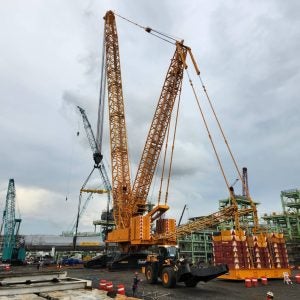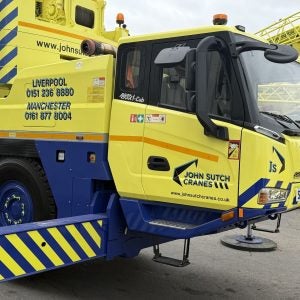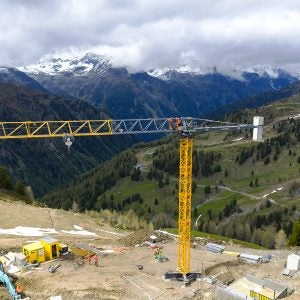According to the company’s managing director, Jason Lindsay, “Due to current planning policy, developers needed to optimise the use of space and maximise the development potential. We opted for a timber frame construction method as this enables a large part of the build process to take place off site, whilst giving us the benefit of fast erection with the minimum of disruption. We also believe that timber frame buildings are going to become much more popular in the future, due to their speed of construction as well as excellent heat and sound insulation benefits.
“Despite this being a greenfield site, there are still issues relating to storage and loading of building materials. Without the use of the VC33, getting materials onto the site would have been difficult as the houses are constructed close together, within close the proximity of the tree lined boundaries to the site. Consequently, there was nowhere that could be easily utilised for the placement or storage of materials. By investing in the VC33 tower crane we have been able to lift the materials into the back gardens where they can be stored until required. The crane is then used to feed materials to the operatives as and when required. The accuracy of placement is extremely impressive, saving us both time and money.
“The VC33 has proved to be ideal for use on this type of development as it can reach places which a telescopic handler cannot get to. It has also enabled us to work much more efficiently. When the bricks and roof tiles arrive on site we can place them with pinpoint accuracy around the house so that the materials are well organised and near to hand for the operatives, saving wear and tear on manpower and helping to make the site a safer environment.”
Not only is the VC33 saving Faycross time and money in term of labour costs, but it has also helped to reduce preliminary costs such as site safety and cabins etc., as the materials can be located out of reach of passers by.
“Reducing overheads and costs is vitally important to a small, family owned construction company such as ourselves”, continued Jason,” as it helps us to compete against larger developers in the industry. By stripping out costs we are able to save money which can be put directly onto the bottom line. Also, buying the crane, rather than renting it, makes better financial sense as we will have the crane to use on other projects when this one has finished.”
The VC33 forms part of Vanson’s VC Range which is designed to provide the construction industry with a new breed of self-erecting tower cranes that offers quick and user friendly operation. As it can be erected within a very small working envelope, it reduces both erection and dismantling costs when compared with conventional tower cranes of a similar size. This capability makes it ideal for operation within congested urban areas where the use of other types of lifting equipment is so often impractical, Vanson Cranes says.
This crane is completely self-contained as it has incorporated a ballast handling derrick to avoid the requirement for third party lifting equipment. Consequently it can be erected and dismantled using just two people. Another major operational advantage of this crane is that the jib is able to fold in half to avoid the crane violating other party’s airspace. Once erected, it is well suited to 3 and 4 storey construction work and has the added advantage of a minimal physical impact on the site, Vanson Cranes says.
To achieve a smooth hook action so that the positioning of the load is much more accurate the VC33 has incorporated a ‘soft-start’ system. By removing the jerky crane motions component wear is minimised which helps to keep the crane in good condition and working well for a longer period of time, Vanson Cranes says.
Faycross’s Vanson VC33 Faycross’s Vanson VC33 Vanson’s latest crane is the LCL20 luffing-jib tower crane Vanson LCL20 luffing-jib tower crane






